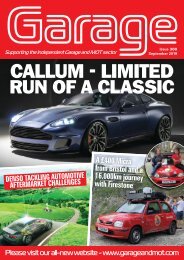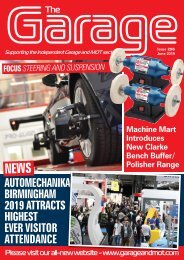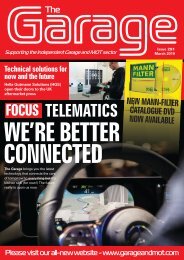Create successful ePaper yourself
Turn your PDF publications into a flip-book with our unique Google optimized e-Paper software.
NEWS 14<br />
DENSO demonstrates quality of OE<br />
radiators and reveals installation tips<br />
Alongside cooling<br />
the engine,<br />
these components<br />
are crucial in helping<br />
reduce a vehicle’s<br />
fuel consumption and<br />
exhaust gas emissions, as<br />
well as ensure the smooth<br />
running of air conditioning<br />
(A/C) and heat exchange performance<br />
of other parts.<br />
DENSO’s engine cooling<br />
products are fitted, as original<br />
equipment (OE), to a<br />
quarter of European cars, so<br />
they are the ideal choice for<br />
technicians. DENSO has the<br />
knowledge and experience<br />
to inform <strong>Garage</strong> readers of<br />
the quality that its aftermarket<br />
programme provides.<br />
Advanced and environmentally-driven,<br />
DENSO’s thermal<br />
products are the market<br />
leaders, not just in Europe,<br />
but, worldwide, with a 30%<br />
share of the OE thermal market.<br />
Demonstrating its credentials,<br />
DENSO develops A/C<br />
and engine cooling systems<br />
for the likes of Audi, BMW,<br />
Mercedes, Toyota, Porsche<br />
and Volkswagen. <strong>The</strong> engineering<br />
quality that goes into<br />
making these components<br />
has filtered down to the independent<br />
aftermarket, as<br />
DENSO only offers OE thermal<br />
management products.<br />
Delving into the range itself,<br />
it comprises of radiators<br />
(1,200 part numbers), intercoolers<br />
(130 part numbers),<br />
cooling fans (200 part numbers),<br />
cabin blower fans (180<br />
part numbers) and heater<br />
cores (70 part numbers).<br />
Radiator installation tips<br />
Focusing on radiators specifically,<br />
the part is at the<br />
heart of the engine cooling<br />
system, releasing the heat extracted<br />
from the engine into<br />
the atmosphere. Traditionally,<br />
the radiator is located at<br />
the front of the vehicle, near<br />
to the air intake, in order to<br />
exploit the dynamics of speed<br />
while the car is on the move.<br />
Radiators fitted within vehicles<br />
that are equipped with<br />
an A/C system will, typically,<br />
be larger and more powerful,<br />
in order to dissipate the heat<br />
discharged by the condenser;<br />
Technicians will come face-to-face with this component in the workshop, but, before<br />
replacing it with a DENSO radiator, what do they need to know? DENSO’s technical<br />
guru, Mike Sadler, reveals his top tips:<br />
• Check that the part number is correct via cross-referencing.<br />
• Before installation, inspect the new part carefully, including the size and fitment of ancillary<br />
parts, such as caps, switches and sensors.<br />
• Carefully examine the radiator hoses and connections, and then replace any with new OE<br />
parts, where necessary. Failure to do so can cause radiator failure. <strong>The</strong> most common<br />
problem is coolant leakage, resulting from defective or worn seals.<br />
• <strong>The</strong>rmostats and caps are also susceptible to faults, which is usually due to inherent defects<br />
in the radiators, but faults relating to OEM and matching quality replacements are rare.<br />
• Avoid inferior alternatives! This may sound like simple advice, but research has shown that<br />
buying cheaper will cost more in the long run, as too often cheaper can mean inferior quality.<br />
• Be careful to avoid physical damage while handling and installing.<br />
• Don’t forget to inspect any defective radiator mountings – bushes and rubbers – which can<br />
be easily-repaired before installing the radiator.<br />
• Coolant antifreeze concentration is also subject to certain regulations, as outlined by the<br />
vehicle manufacturer (VM). When fitting a new radiator, be sure to check that the correct<br />
concentration has been used.<br />
• As the radiator releases heat, which is exchanged from the engine into the air, check<br />
the performance and operation of the electric cooling fans after the new radiator has been<br />
installed.<br />
• If in doubt, check the VM’s guidelines. VMs provide best practice information and<br />
procedures for each vehicle it manufactures. Block Exemption Rules ensure this information<br />
is freely-available to technicians.<br />
Further details are available online at www.denso-am.co.uk<br />
however, DENSO’s radiators<br />
are smaller, lighter and offer<br />
greater heat exchange than<br />
most of its competitors.<br />
This is possible because<br />
DENSO’s radiators are designed<br />
meticulously, co-developed<br />
with A/C experts and<br />
made to deliver an efficient<br />
performance; for instance, a<br />
DENSO radiator with a 0.2<br />
sqm front surface features<br />
more than 6 sqm of cooling<br />
surface on its fins.<br />
Other key features include<br />
‘blaze welding’, which creates<br />
a closer contact between tube<br />
and fin for more efficient heat<br />
transmission, ‘mechanical<br />
deformation’, which means<br />
the tube is ‘pressed’ against<br />
the fin, offering less contact<br />
but a lower production cost.<br />
14, 15 Denco.indd 1 27/08/2019 10:03
















